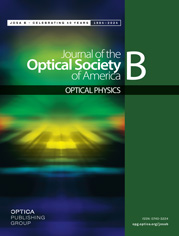JOSA B Feature Announcement
Physics and Applications of Supercontinuum and Frequency-comb Generation in Waveguides and Micro-resonators
Submission Opens:1 October 2016
Submission Deadline: 1 November 2016
Supercontinuum generation—a process in which narrow-band laser light undergoes extreme nonlinear spectral broadening—was first reported in bulk crystals and glasses in the 1970s. It has since been the subject of numerous investigations in various media due to its wide range of potential applications. The invention of photonic crystal fibers in the 1990s together with the rapid development of compact and reliable high power lasers revolutionized the field, and the 2000s saw the demonstration of octave-spanning spectra using input pulses ranging from the femtosecond regime to the nanosecond, and even from high-power continuous-wave lasers. Of particular note is coherent, broadband frequency comb generation from high repetition rate lasers, (with numerous applications to metrology), which has triggered the birth of a new field of investigation dedicated to the generation of frequency combs in micro-resonators. Efforts to understand the physical mechanisms involved in the extreme spectral broadening of supercontinuum generation in fibers and frequency comb generation in micro-resonators have revealed that these processes share very closely connected dynamics. The rapid development of the field, both theoretically and experimentally, has matured the technology enough to bring supercontinuum sources to a commercial level.
Development of new types of waveguides, micro-resonators and laser sources will open up the possibility of new applications for supercontinuum generation. This feature issue will present the current status of the field as well as emphasize the new challenges it faces in terms of average power, coherence properties, enhanced spectral coverage, and miniaturization.
Topics for this special issue include:
- Supercontinuum generation in new kinds of waveguides: soft and infrared glass fibers, gas-filled fibers, nanowires, silicon fibers and waveguides, multimode fibers, etc.;
- Coherent supercontinuum generation schemes;
- The generation and characterization of frequency combs in waveguides and micro-resonators;
- Temporal and spectral characterization techniques;
- Applications of supercontinuum sources in bio-imaging, sensing, spectroscopy, etc.;
- Applications of frequency combs for metrology, high resolution spectroscopy, atomic clocks, etc.
All papers need to present original, previously unpublished work, and will be subject to the normal standards and peer-review processes of the journal. Manuscripts must be prepared according to the usual standards for submission to JOSA B and uploaded through OSA's electronic submission system, specifying from the drop-down menu that the manuscript is for the Feature Issue on "Physics and applications of supercontinuum and frequency-comb generation in waveguides and micro-resonators" feature (choose from the feature issue drop-down menu).
Feature Issue Editors
Miro Erkintalo, Univ. of Auckland, New Zealand
Alexandre Kudlinski, Univ. of Lille, France
John Travers, Heriot-Watt University, UK
Stefan Wabnitz, Univ. Of Brescia, Italy

